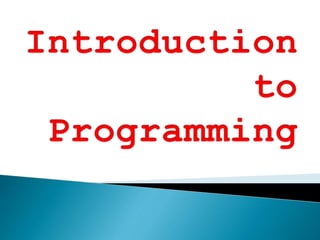
introduction to programming
- 2. Program is a set of a step- by-step instructions that tells or directs the computer what to do. Programmer designs the program, decides which of the programs or set of instructions to use and tests the program to see if it is working as designed.
- 3. 2. Planning the Solution 3. Coding the Program 4. Testing the Program 5. Documentation 1. Identifying the Problem
- 4. 1. Identifying the Problem It involves determining the requirement of the program. You have to analyze the need to be able to come up with a suitable programming solution. 2. Planning the Solution There are two ways of planning the solution to a problem, they are flowchart and pseudo-code. Flowchart – graphical representation of the step by step instruction. Pseudo-code – listing down the set of instructions. 3. Coding the Program Visual Basic - is used as the programming language. Syntax – Set of rules of programming language. Syntax Error – If a rule is violated, it will produce error like misspelling.
- 5. 4. Testing the program Desk checking – The programmer just mentally traces or checks the program to make sure that it is error free. Translation – The programming language uses a translator to ensure that the programmer did not violate any language rules. Debugging – This means detecting, locating and correcting bugs. 5. Documentation The programmer makes a detailed description on how the program was created. It contains a brief narrative process undergone by the program from the first step up to the fourth step
- 6. Symbol Name Action RepresentedPicture Shape Oval Terminal Symbol Represents start and end of program Parallelogram Input/ Output Indicates input and output Rectangle Process This represents processing of action e.g. mathematical operator Diamond Decision Answer the question yes/ no Hexagon Initialization / Preparation Prepare memory for repetition of an action
- 7. Symbol Name Action RepresentedPicture Shape Arrow Lines & Arrow Heads Direction Shows the flow of the program Annotation Used to describe action or variables Circle On page connector Connector or part of program to another part Pentagon Off-page connector Connect part of a program to another part on the other page or paper
- 8. Sequence – process is executed from one to another in a straight forward manner.
- 9. Flowchart: Algorithm: Step 1: Read the value of N Step 2: Print the value of N Start Read N Print N End
- 10. Procedural Languages – programming languages which are considered procedural uses a series of instructions or statements which are sequential from beginning to the end. Example: BASIC (Beginner’s All-purpose Symbolic Instruction Code) COBOL (Common Business Oriented Language) PASCAL FORTRAN (Formula Translator) C PL1 (Programming Language 1)
- 11. Non-Procedural Languages – programming languages are considered as object-oriented programming languages. They are event- driven which means that a programmer selects an event that needs to occur before the instruction or statement is executed. Example: VISUAL BASIC C++ JAVA DELPHI
- 12. Flowchart – is one of the processes used in designing or planning the solution to a problem. It is a graphical representation to the solution of a problem. It uses shapes to show instructions and arrow lines and heads to display the flow.
- 13. Machine Language or First Generation Programming Language Assembly Languages or Second Generation Programming Language High Level Language or Third Generation Programming Language (3GL) Very High Level Languages or Fourth Generation Languages (4GL) Natural Languages
- 14. This is considered to be the lowest level of programming language. The program is represented by 1s and 0s. We all know that 1s and 0s or binary number is the only language the computer understands. Machine language programming is a very tedious task because for just a simple task, the program code required would be very long.
- 15. This is also considered as low level language. However, programmers would find this language easier to use than machine language. Instead of using 1s and 0s, assembly language uses mnemonic codes. Mnemonic codes are abbreviations that are easy to remember. Each type of computer has its own assembly language. This means that once you have started your programming, you cannot use a different computer to continue your work.
- 16. This language transformed programming in the early 1960s. It makes programming easier since the language is now written in English like manner. If assembler is used by assembly language, third generation languages use translator to convert the program into a machine language.
- 17. Fourth generation languages (4GL) simplifies further the third level generation languages (3GL) because there is a reduction in the number of instructional statements. One hundred (100) lines of instructions in 3GLs can be reduced to five (5) to twenty (20) lines of instructions in 4GLs.
- 18. These languages are considered to be that fifth generation languages. These programming languages are called natural languages because of their resemblance to English language. Natural Languages have the capability to translate human instructions into code that a computer understands. If it gets confused with the user’s instructions, it asks for further explanation.
